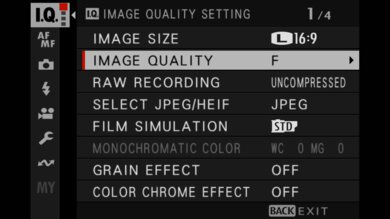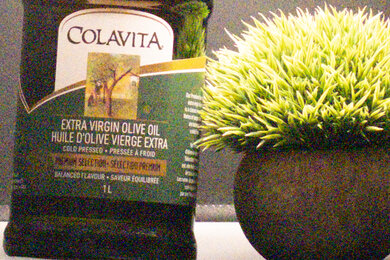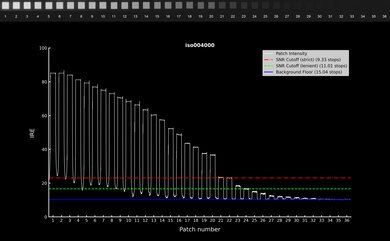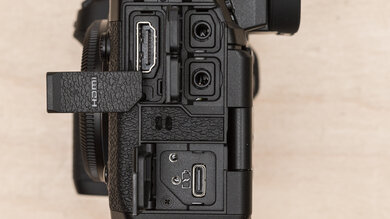The Fujifilm X-H2S is one of two flagship Fujifilm APS-C cameras. Like its sister model, the Fujifilm X-H2, it has a heavy-duty build and long battery life. However, instead of a 40-megapixel sensor, it uses a 26-megapixel sensor with a stacked design that gives it a faster readout speed and minimizes rolling shutter. True to its name (the S stands for speed), this is the model to get for video work and fast-moving subjects, with advanced video capability and recording at up to 6.2k, in-body image stabilization (IBIS), and blackout-free burst shooting at up to 40 fps.
Our Verdict
If you don't mind a bulkier camera, the Fujifilm X-H2S is great for travel photography. It has an excellent battery life for a mirrorless camera, so it can last long days on the go, depending on your shooting habits. Image quality is also amazing, and it has a very effective autofocus system for faster subjects or busier scenes. To top it off, it's sturdily built and weather-sealed, giving you peace of mind when shooting outdoors.
- Excellent battery life.
- Very effective autofocus system.
- Fantastic build quality and ergonomics.
- Excellent overall image quality.
- Bulky for an APS-C camera.
The Fujifilm X-H2S is great for landscape photography. It can capture high-quality images straight out of the camera, and its RAW dynamic range is great, making it well-suited to high-contrast scenes like landscapes. It's also well-built, weather-sealed, and has a very good battery life for a mirrorless camera. It also has a high-resolution sensor, but it isn't the highest resolution on the market, so you don't have quite as much cropping leeway as a camera like the Fujifilm X-H2, for example. Still, it's more than enough resolution for most people, especially if you mostly share your work online.
- Excellent battery life.
- Fantastic build quality and ergonomics.
- Excellent overall image quality.
- Great dynamic range.
- Bulky for an APS-C camera.
The Fujifilm X-H2S is excellent for sports and wildlife photography. Its stacked sensor allows for e-shutter burst shooting at up to 40 fps without EVF blackout and with minimal rolling shutter effect, making it very well-suited to capturing sports and action. The camera also has a great autofocus system, with many different subject-detection modes for humans, animals, birds, and vehicles. Image quality is also excellent overall, and the camera feels very well-built and comfortable to use, with a weather-sealed body and large ergonomic grip.
- Blackout-free burst shooting at up to 40 fps.
- Excellent battery life.
- Very effective autofocus system.
- Fantastic build quality and ergonomics.
- Excellent overall image quality.
- Bulky for an APS-C camera.
The Fujifilm X-H2S is too bulky for on-the-go vlogging, but it's good for sit-down or in-studio vlogging. It has a fully articulated screen that makes it easy to monitor yourself while recording. It's also an incredibly capable video camera, with video recording at up to 6.2k, plenty of frame rate options, and advanced video formats and codecs. However, many of its more advanced video features will be overkill for most vloggers.
- Fully articulated screen.
- Excellent video quality.
- Incredible internal recording capability.
- Bulky for an APS-C camera.
- Can overheat during long recording sessions.
The Fujifilm X-H2S is amazing for studio video. It can record video at up to 6.2k with internal 10-bit 4:2:2 color from the full width of the sensor. 6.2k and 4k up to 30 fps are also recorded from a 14-bit readout when using the F-Log2 profile, allowing the camera to capture a very wide dynamic range. On top of that, it supports high-quality, low-compression Apple ProRes codecs internally and RAW video output with a compatible external recorder. The stacked design of its sensor keeps rolling shutter effect to a minimum, too. Plus, you get a full-sized HDMI port and inputs for video accessories like a mic and headphones. Its battery life is also great, and there's no recording time limit. However, it can also overheat during long recording sessions, though Fujifilm sells an optional cooling fan accessory meant to reduce the risk of overheating.
- 6.2k and 4k at 30 fps from 14-bit readout.
- Internal Apple ProRes codec support and external RAW video output via HDMI.
- Uncropped 4k at up to 60 fps.
- Bulky for an APS-C camera.
- Can overheat during long recording sessions.
The Fujifilm X-H2S isn't meant for a POV-style action video but works well for recording the action from the sidelines. It's an incredibly capable video camera, with video recording at up to 6.2k. It also includes plenty of frame rate options for high-speed video, including uncropped 4k at up to 60 fps, with a slow-motion mode that records 4k at 120 fps. That said, while it's a well-built camera, it isn't designed for action rigs, and though it's weather-sealed, it isn't fully waterproof.
- Very effective autofocus system.
- Slow-motion mode with 4k up to 120 fps and 1080p up to 240 fps.
- Excellent video quality.
- Bulky for an APS-C camera.
- Not designed for action video rigs/mounts.
- Weather-sealed but not waterproof for watersports.
The Fujifilm X-H2S has good RAW photo performance. Its dynamic range is great, so it can capture a wide range of highlight and shadow detail. It also has a remarkably high-resolution sensor that captures plenty of fine detail and gives you some added leeway to crop in. However, its noise handling in low light is just decent.
- Great dynamic range.
- Very high resolution.
- Decent noise handling.
Performance Usages
Changelog
-
Updated Dec 12, 2024:
We wrote text for the new tests added in Test Bench 0.13 and updated the Verdict section accordingly.
- Updated Dec 12, 2024: We've converted this review to Test Bench 0.13. We've added new tests for Video Dynamic Range and Luminosity Patch Detection. You can learn more about these updates in the changelog.
- Updated Jan 29, 2024: Added text to the 'Raw Photo Performance' verdict box.
- Updated Jan 29, 2024: Converted to Test Bench 0.12.1.
Check Price
Differences Between Sizes And Variants
The Fujifilm X-H2S comes in one color, Black. You can see our unit's label here. The camera body is primarily sold on its own, but depending on the retailer, you can buy it in a bundle with one or more lenses.
Let us know if you come across any other variants, and we'll update our review.
Popular Camera Comparisons
The Fujifilm X-H2S is one of the most capable hybrid APS-C cameras on the market, and it comes with a price tag to match. It sits at the top of Fujifilm's mirrorless APS-C lineup alongside the Fujifilm X-H2. The cameras are similar, but while the Fujifilm X-H2 has a 40-megapixel sensor, the X-H2S uses a stacked 26-megapixel sensor. The stacked design allows for a faster sensor readout speed, which enables quicker burst shooting with less rolling shutter and no EVF blackout. However, it can't record 8k video like the X-H2.
If you're looking for more options, look at our recommendations for the best mirrorless cameras, the best cameras for filmmaking, and the best cameras.
The Fujifilm X-H2 and the Fujifilm X-H2S are both amazing APS-C cameras with identical builds, but they use different sensors geared toward different uses. The X-H2S has a stacked 26 MP sensor that's ideal for video and action photography thanks to its faster readout speed, which allows for blackout-free burst shooting and minimizes rolling shutter effect. The X-H2, on the other hand, uses a higher-resolution 40 MP sensor that makes it better for portraits and landscapes, giving you plenty of leeway to crop and edit your photos. Both are also extremely capable video cameras, though the X-H2 can record 8k video while the X-H2S caps out at 6.2k. However, the X-H2S's faster readout means less rolling shutter distortion in video.
The Canon EOS R6 Mark II and the Fujifilm X-H2S are amazing hybrid cameras but use different sensors. The Fujifilm uses an APS-C sensor, so it doesn't have as much dynamic range as the Canon's full-frame sensor, which is also better suited to low-light shooting. Both cameras suit action photography well, with effective autofocus systems and quick e-shutter burst shooting. However, the Fujifilm's sensor has a stacked design that keeps rolling shutter distortion to a minimum. Both cameras have fantastic internal video recording capability, but the Fujifilm can record 6.2k video and has internal Apple ProRes support.
The Fujifilm X-H2S and the Sony α7 IV are excellent hybrid cameras with different-sized sensors. You'll get a higher resolution and more dynamic range in your photos with the Sony, thanks to its 33 MP full-frame sensor. On the other hand, the Fujifilm uses an APS-C sensor with a stacked design that allows for faster burst shooting with no EVF blackout and minimal rolling shutter effect. The Fujifilm is also the more capable video camera, with video recording in up to 6.2k, uncropped 4k at up to 60 fps, internal ProRes codecs, and RAW video output via HDMI. However, if you don't need all of these features, the Sony is still an excellent choice for video work. The Sony also has a slightly more reliable autofocus system.
The Fujifilm X-H2S is more capable than the Fujifilm X-T4, with an improved autofocus system, better internal video capability, and a stacked sensor design that allows for faster burst shooting with minimal rolling shutter effect. That said, it can also be overkill for many people, particularly if you don't need its advanced filmmaking features. The X-T4 may be better if you want a more portable hybrid camera with dedicated exposure control dials.
Test Results

The Fujifilm X-H2S isn't the most portable camera, especially for an APS-C model. Its dimensions are identical to the Fujifilm X-H2, and it's similar in size to many full-frame mirrorless cameras, like the Sony α7 IV. However, it still feels well-balanced with sizeable lenses, including larger cinema lenses.
Like the Fujifilm X-H2, the camera feels remarkably well-built. It's advertised to have 79 weather-sealed points to keep out dust and moisture. Inputs and outputs are covered with sturdy doors, including a locking hinged door for the battery and memory card compartments. It's also rated for up to 500,000 shutter actuations, according to Fujifilm. Ultimately, it's a very well-built camera that can withstand extensive use and tough weather conditions.
Unlike the Fujifilm X-H1, the Fujifilm X-H2S forgoes dedicated exposure dials in favor of a PSAM dial. There are a few other design differences, including a redesigned joystick. The camera body is identical to the Fujifilm X-H2.
The camera's ergonomics are superb. The grip is roomy and comfortable, with a textured finish that doesn't feel slippery. Unlike cameras in the X-T series, like the Fujifilm X-T4, it doesn't have the dedicated exposure dials that Fujifilm fans may be used to. That does make it a little harder to quickly change your exposure settings. Still, thankfully, the camera has plenty of customization options, so you can remap the dials to your preference. With firmware update Ver. 5.00, you can set ISO to one of the command dials, while before, you could only change ISO by pressing the ISO button and then turning a dial. If you have smaller hands, some buttons, and even the AF point joystick, can be hard to reach because of the camera's larger size. However, on the whole, they're well-spaced out.
The camera's electronic viewfinder (EVF) has a very high resolution, higher than most competitors, allowing for a very clear and sharp view. You can set the refresh rate to 120 fps in 'Boost' mode for a smoother image, but this impacts the resolution and will drain the camera's battery quicker. There's also a '240p equivalent' mode with reduced brightness.
The screen is large and bright, with a high resolution that ensures a sharp image when shooting in Live View. It's fully articulated, which is ideal for video recording and makes it easier to shoot at unusual angles. You can use the touchscreen to select focus points or to fire the shutter. However, you can only use it to change settings in video mode.
There's a secondary display on top of the camera that shows info about battery life, storage space, and settings at a glance. You can toggle it between light and dark mode.
The menu system is great. It's easy to navigate using the joystick or the directional pad on the back of the camera. The interface has a fairly intuitive layout, although some of Fujifilm's terminology differs from other brands, e.g., metering settings are called 'Photometry' settings. While the menu may take some time to get used to, it's easy to navigate once you get a handle on it. There's also an info function if you need certain settings explained. However, it isn't as in-depth as the help function on cameras like the Canon EOS R6 Mark II.
There's also a customizable quick menu for commonly used settings. It doesn't fully obstruct your view on the screen, so you can see any adjustments as you make them. You also have customizable 'My Menu' pages for photo and video, allowing you to create a custom menu limited to the specific settings you wish to access. Overall, these extensive customization options, including swipe motions for the screen and almost all of the camera's buttons, allow you to tailor the shooting experience to your preferences.
This camera is also compatible with the new XApp, which offers smoother wireless connectivity between X series cameras and smartphones than the older Fujifilm Camera Connect app, according to Fujifilm. We didn't find a huge difference in performance between the new one and the old Camera Connect app, especially after the latest software updates for Camera Connect. However, the XApp is well-designed and offers plenty of functionality through Bluetooth and Wi-Fi, including use as a remote for the camera, backup for your settings, and file transfer from your camera to your smartphone (excluding RAW files). The Timeline and Activity features are neat ways to keep track of your photo history and shutter count. When connected to the camera via Wi-Fi, you can also use the app for Live View, but it can be a bit laggy, and you won't have access to every setting. The signal range is also limited and easily disrupted when there are obstructions between your phone and the camera. If you'd like to see the XApp in action, you can see a brief video tour of the app here.
The Fujifilm X-H2S uses a stacked BSI (backside illuminated) CMOS sensor. According to Fujifilm, the stacked design allows four times faster readout speeds than the X-Trans CMOS 4 sensor found on models like the Fujifilm X-T4. The faster readout allows the camera to shoot without EVF blackout and helps reduce rolling shutter effect. The new X-Processor 5 is also supposedly twice as fast as the previous generation.
The camera's battery life is fantastic. It has a 580-shot CIPA rating, making it one of Fujifilm's best so far when it comes to photography. CIPA ratings are to be taken with a grain of salt, and your actual mileage will vary depending on your settings and how you use your camera. However, relative to other mirrorless cameras, the rating is excellent. There's also a power-saving 'Economy' mode, which bumps the rating up to 720 shots on a full charge.
In video mode, we recorded continuously in 4k at 30 fps for a little over two hours before the battery died. That number will vary depending on your settings, but it's excellent relative to other cameras. That said, your effective recording time can be limited by overheating.
To extend the battery life, use a USB-C connection for an external power supply. Fujifilm also sells an optional battery grip that can triple the camera's battery life.
The Fujifilm X-H2S has impressive continuous shooting capabilities. Thanks to its stacked sensor, you can shoot at up to 40 fps with the e-shutter with minimal rolling shutter effect and no EVF blackout, which is remarkable. When using the mechanical shutter, the camera can still shoot at up to 15 fps, which is still fantastic and very suitable for fast-moving subjects.
The buffer capacity is also great, particularly if you're using a high-speed CFexpress Type B card. If you're shooting JPEGs, you'll have a virtually infinite buffer. When shooting in RAW, you can fire over 150 frames before slowing down, which is excellent. Once the camera reaches full capacity, there's a bit of a delay before you can shoot at full speed again, but it's relatively short. With a high-performance SD card, on the other hand, the RAW buffer is a bit smaller, but we were still able to shoot 113 frames before it slowed down. That said, it takes much longer for the buffer to clear when using an SD card, which can slow you down or interrupt your shooting at a critical moment. JPEG shooting is still effectively infinite with an SD card.
The Fujifilm X-H2S uses a hybrid autofocus system. Its subject detection system uses deep learning to automatically detect a wide array of subjects, including human faces and eyes, animals, birds, and vehicles like cars, bikes, airplanes, and trains. However, the various subject detection modes are separate from human face/eye detection, which makes it a hassle to switch from humans to other subjects.
The AF tracking works well with moving human subjects in burst mode, with a very high rate of usable shots. It can still lose track of more erratic subjects or unintentionally shift focus to a different target. Ultimately, the autofocus isn't quite as "sticky" or seamless as the latest Canon and Sony cameras, like the Canon EOS R6 Mark II or the Sony α7 IV, respectively. However, it's by far Fujifilm's best autofocus tracking system to date and is still very effective overall.
The AF is incredibly effective without tracking and using a single center focus point. It has no trouble staying with moving subjects behind the focus point. We tested AF using the Fujinon XF 16-55mm f/2.8 R LM WR lens, which uses a quick linear motor.
The Fujifilm X-H2S has five-axis in-body image stabilization, which the manufacturer advertises to offer up to 7 stops of compensation. We tested image stabilization using the Fujinon XF 16-55mm f/2.8 R LM WR lens, which doesn't include optical stabilization. Yet, we could still capture clear handheld shots at very slow shutter speeds.
The camera's usable dynamic range is great. It captures a wide array of highlight and shadow detail, although not as much as the Fujifilm X-H2, which has a wider dynamic range, especially at base ISO.
While the Fujifilm X-H2S doesn't have as high a resolution as the 40 MP Fujifilm X-H2, it can still capture plenty of fine detail. You won't have as much leeway to crop your photos, but images are still quite sharp.
Noise performance is good for an APS-C sensor. It performs well in low-light situations where noise becomes more apparent. It's a tad better than the Fujifilm X-T4 when it comes to noise, but the difference isn't significant in most cases.
In addition to Full HD and 4k, the Fujifilm X-H2S can also record open gate 6.2k video with a 3:2 aspect ratio at up to 30 fps, with 10-bit 4:2:2 color. That is, it can record video from the full height and width of the sensor, giving you more flexibility in post-production. 6.2k and 4k video up to 30 fps are recorded from a 14-bit readout thanks to the stacked sensor. Typically, consumer cameras have to switch to 12-bit readout in video mode, so the 14-bit readout is quite an achievement.
The camera can record in F-Log and the new F-Log 2, which is meant to take advantage of the 14-bit readout to capture an expanded dynamic and tonal range. The X-H2S also supports RAW video output via HDMI to a compatible Atomos or Blackmagic external recorder, with support for 12-bit Apple ProRes RAW or Blackmagic RAW, respectively, in 6.2k at up to 30 fps.
In addition to most common recording formats and codecs, the Fujifilm X-H2S can also record in Apple ProRes 422 HQ, Apple ProRes 422, and Apple ProRes LT formats, which is remarkable for a consumer camera. However, you must use a CFexpress card to use these ProRes formats.
The Fujifilm X-H2S can record regular 4k video at up to 60 fps without a crop. It's one of the few cameras we've tested so far that can do uncropped 4k / 60 fps, alongside the Canon EOS R6 Mark II.
Taking things even further, the camera can also record 4k video at 120 fps in its high-speed recording mode. This mode is for dedicated slow-motion shots, so it doesn't record any sound. You can set the playback speed to 24 fps (5x slow motion), 30 fps (4x slow motion), or 60 fps (2x slow motion). It also incurs a crop.
The camera has incredible internal 4k recording capability. Fujifilm says the camera can record an expanded dynamic range with the new F-Log 2 gamma curve—over 14 stops. With 10-bit 4:2:2 color, you can also make the most of those Log profiles with more flexibility when grading and editing.
There's no recording time limit, which is great for long-form recording. However, your effective recording time can be limited by overheating. We experienced a couple of overheat interruptions while doing our battery life test, although the second overheat occurred right before the battery died. Fujifilm sells a cooling fan accessory that you can screw into the back of the camera when the screen is fully extended. It's meant to help reduce overheating during long recording sessions, but we haven't tested it.
The exceptionally high bit rates noted above were achieved using the ProRes 422 HQ codec. When using the default H.264 LongGOP codec, the max bit rate we recorded was 349 Mbps. The bit rates you get will vary depending on the file format, codec, and other settings.
The autofocus is incredibly effective in video mode. Focus transitions are pretty seamless, with little to no delay when a subject or object moves within the frame. It isn't perfect, as it can occasionally trip up and shift to the background, but that's rare. Overall, this is a fantastic set-it-and-forget-it AF system.
That said, there are some quirks with the user interface and experience. The face/eye detection mode is separate from the other subject detection modes, which include Animal, Bird, Automobile, Motorcycle, Airplane, and Train. The latest firmware supports insects (under 'Bird' detection) and drones (under 'Airplane' detection). While the extent of subjects is great, having them separate makes it a hassle to switch between tracking human subjects and other subjects. On the upside, the camera's extensive customization options make it easy to access and adjust these settings quickly.
The video quality in 4k is excellent. It's oversampled from the full 6.2k width of the sensor, so the quality is superb, with very detailed footage. When using the 120 fps slow-motion mode, quality is still great, which you can see here. The video quality is still great in low light, too. There's some inevitable noise, but it's fairly minimal, and the image looks sharp and detailed.
The Fujifilm X-H2S's stacked sensor has a very quick readout speed, minimizing rolling shutter distortion. There's significantly less rolling shutter effect than the Fujifilm X-T4 or the Fujifilm X-H2, and it blows the Sony α7 IV out of the water.
The Fujifilm X-H2S can record regular full-speed 1080p video at up to 60 fps without a crop. There's also a high-speed recording mode, which can record slow-motion footage at up to 240 fps, with playback options for 2x, 4x, or 8x slow motion. This mode doesn't record any sound and imposes a significant crop.
The camera's internal recording capability in Full HD is fantastic. As with 4k, it can record 10-bit 4:2:2 video internally. There's also no recording time limit, and overheating is less likely to be an issue in 1080p.
We recorded the above bit rates using the ProRes 422 HQ codec, which requires a CFexpress card. When recording in the default H.264 LongGOP, we got a max bit rate of 349 Mbps and a minimum of 183 Mbps. Bit rates will vary depending on your settings.
The autofocus is incredibly effective in video mode. Focus transitions are pretty seamless, with little to no delay when a subject or object moves within the frame. It isn't perfect, as it can occasionally trip up and shift to the background, but that's rare. All in all, this is a fantastic set-it-and-forget-it AF system.
The 1080p video quality is also amazing, especially in more controlled lighting conditions, where videos look very sharp and detailed. It also does a good job in low light, although it looks a bit muddier, with some inevitable noise and loss of detail.
Unfortunately, the quality degrades significantly when using the high-speed recording mode in 1080p, especially when shooting at 240 fps. You can see a sample test scene extract from a 1080p / 240 fps slow-motion video clip here.
There's very little rolling shutter effect in 1080p, as well. Skewing and distortion aren't very noticeable, even with quicker camera pans.
The Fujifilm X-H2S has excellent overall video dynamic range. When shooting in F-Log2, it can capture a remarkably wide range of detail above the background floor. Once you take noise into account, however, you're looking at a usable dynamic range of around 9 to 11 stops, depending on how much noise you're willing to tolerate. That's a bit less than the Fujifilm X-H2, but that's to be expected, given the X-H2S's stacked sensor and slightly higher base ISO. It's still great overall, though, and the difference in practice is marginal. All in all, the camera is well-suited to recording in high-contrast environments.
Tested settings:
- Resolution: 4k
- Frame Rate: 30 fps
- Log Format: F-Log2
This is the first X-series camera to feature a full-sized HDMI port, which is fantastic for videographers since they won't need to use an adapter when connecting an external recorder. The camera also has a mic input, headphone jack, and USB-C port for charging, power supply, and file transfer. On the other side of the camera, you also have a remote input, and on the bottom of the camera is the battery grip connection.






















